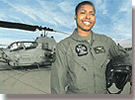
MARINE CORPS BASE CAMP PENDLETON, Calif. (February 13, 2003) --
Those who have spent enough time with 1st Lt. Vernice Armour will tell you there are two distinctive sides to the 29-year-old Marine Corps officer. One is an intensely competitive, openly confident athlete; the other is a quiet but self-assured Super Cobra pilot.
In the latter capacity, Armour is a high-flying example of social progressiveness in the U.S. military - the first-ever African-American female combat pilot. But most people don't realize it amid her quiet composure.
As an athlete, Armour is one of Camp Pendleton's most notorious - having won back-to-back titles in the female division at the annual Strongest Warrior competition in 2001 and '02, and ultimately the base's 2001 Female Athlete of the Year Award.
For good measure, the multi-sport athlete played running back for the San Diego Sunfire women's professional football team during the 2001 season.
During athletic competitions, Armour, a Memphis, Tenn., native, is anything but demur.
By contrast, in her role as a Marine, Armour is an altogether different person. The confidence is still there, but she is much more reserved in her approach to her job.
For Armour, competing for sports trophies is fun stuff. But flying missions for Marine Light Attack Helicopter Squadron 169 is strictly serious business - especially with the clock counting down to deployment and her first potential date with combat.
Although she admits to being nervous about the possibility of going to war, Armour says her training has thoroughly prepared her for impending conflict.
"It's OK to be a little nervous," Armour says. "When the time comes, we'll all be prepared for whatever we have to do - that's what we've been training for."
After graduating from Middle Tennessee State University in 1997, Armour, fresh off a stint as an Army reservist, joined the Marines in October 1998 - "to be in the best fighting organization in the world." She was "winged" in early July 2001 and arrived at Camp Pendleton later that same month.
In March 2002, Armour earned distinction as the Department of Defense's lone African-American female combat pilot and was assigned to HMLA-169.
Armour says being a Marine has "been a great experience" that has "helped build my sense of independence, my leadership abilities and self-reliance."
Armour's broad shoulders not only carry the weight of being a part of U.S. military history, but also of a role model for future generations who will follow in her boot tracks.
She says her trailblazing career has come without any special help or hindrances.
"I haven't been treated any differently or received any more special attention than anybody else just because I'm an African-American or because I'm a woman," says Armour. "The training I've received is the same as my male counterparts, and I've advanced through the (flight training) program just the same as everyone else.
"I don't look at this on the basis of gender or color. I'm a Marine Corps officer first, then I try to be the best officer that I can, and try to take care of the Marines in my charge the best way I can," added Armour, who expects to pin on captain's bars in April.
Armour hasn't shrunk away from her role model status.
"I've put more pressure on myself because I want to succeed, and I want to be the best that I can be. I realize that I'm a role model, and there's more pressure with that, because I do want to set the right example for young people out there, whether they are a boy or a girl, or whether they are black or white. There is more pressure when you try to do that, because you always want to make sure that you are doing the right thing."
Despite the added pressure, Armour welcomes the challenge of both combat aviation and her social-icon status.
"I do want to be that positive role model, I relish it," she says.
"If you do what average people do, you have what average people have. I don't ever want to be average. That's what I challenge kids to do - be better than average."
Lt. Col. Lloyd Wright, HMLA-169's executive officer, acknowledges that Armour, like anyone else who can make the grade as a Marine combat pilot, is anything but average.
"To be a Marine Corps pilot, you have to work hard and have dedication to your goals; obviously, Lt. Armour is a good example of that, " says Wright.
Armour is almost euphoric when describing training to become a Super Cobra pilot.
"It's been great - just awesome," she says, noting her squadron's time spent on developing warfighting skills may soon come to the test.
"We're ready. We train for this every day - to protect our nation and its freedoms - and right now we're getting ready to do just that. Some people who have had a 20-year career have never had the opportunity to do what we're about to do."
Wright confirmed Armour is ready to put her training to the test.
"Lt. Armour, just as every Marine here in this squadron, has worked hard over the last few months to train for this," Wright said. "She is anxious to validate the traits and capabilities and combat tasks she has learned."
Before heading off to parts unknown, Armour offered this bit of advice to the nation's young men and women:
"Don't let anyone dash your hopes and dreams. Decide what and where you want to be and take positive steps to get there," she said.
"Research what it is you want to do, take an interest in it and go for it. Work hard to keep your dreams alive."
Armour also offered her fellow Marines some advice:
"Stay the course," she said. "Be true to yourself and the Corps, and make the right decisions to get where you want to be."
Published by: MCB Camp Pendleton
Story Identification Number: 2003213193257
Story by John Raifsnider